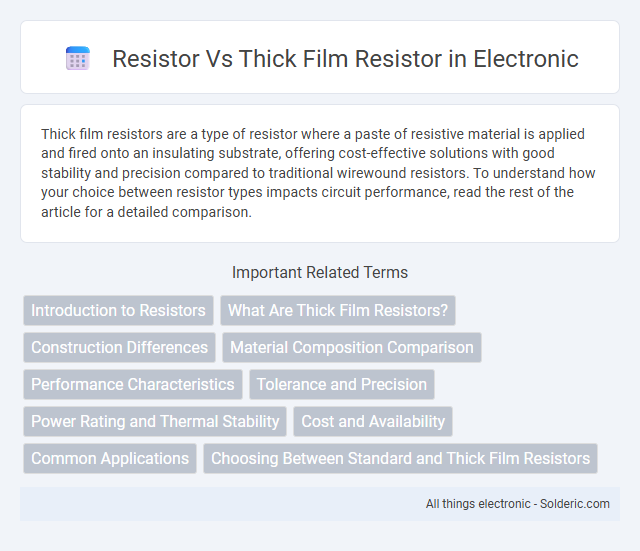Thick film resistors are a type of resistor where a paste of resistive material is applied and fired onto an insulating substrate, offering cost-effective solutions with good stability and precision compared to traditional wirewound resistors. To understand how your choice between resistor types impacts circuit performance, read the rest of the article for a detailed comparison.
Comparison Table
| Feature | Resistor | Thick Film Resistor |
|---|---|---|
| Construction | Wire-wound or carbon film | Conductive paste fired on ceramic substrate |
| Tolerance | +-0.1% to +-5% | +-1% to +-5% |
| Power Rating | Up to 100W | Typically 0.05W to 3W |
| Temperature Coefficient | 5 to 50 ppm/degC | 100 to 300 ppm/degC |
| Size | Larger, bulkier | Compact, surface mount available |
| Frequency Response | Good for high frequency | Moderate frequency stability |
| Cost | Higher cost | Low cost, mass-producible |
| Application | High-power, precision circuits | General purpose, SMD electronics |
Introduction to Resistors
Resistors control electrical current flow by providing precise resistance within circuits, featuring various types based on material and construction. Thick film resistors use a paste of conductive materials applied to an insulating substrate, offering better stability and tolerance compared to traditional wirewound or carbon film resistors. Your choice between standard resistors and thick film resistors depends on factors like precision requirements, durability, and application environment.
What Are Thick Film Resistors?
Thick film resistors are electronic components made by depositing a film of resistive material onto an insulating substrate, typically ceramic, which results in a precise and stable resistance value. Compared to standard resistors, thick film resistors offer enhanced performance with better tolerance, higher power ratings, and improved reliability in various applications. Your electronic designs benefit from their cost-effectiveness and versatility in high-volume manufacturing.
Construction Differences
Thick film resistors are constructed by depositing a paste composed of conductive particles and glass onto an insulating substrate, followed by firing at high temperatures to fuse the materials. Traditional resistors, such as wirewound or carbon film types, use different materials and manufacturing processes, with wirewound resistors employing a metal wire wound around an insulating core. Your choice depends on factors like precision, power rating, and application stability, as thick film resistors offer compactness and consistent performance due to their layered ceramic structure.
Material Composition Comparison
Resistors are typically made from carbon composition, metal oxide, or wire-wound materials, while thick film resistors consist of a ceramic substrate coated with a paste containing conductive particles, glass frit, and organic binders. Thick film resistors offer enhanced stability and precision due to their uniform ceramic base and controlled film thickness, improving performance in high-frequency and temperature-sensitive applications. The material composition of thick film resistors provides better resistance tolerance and reliability compared to traditional carbon composition resistors.
Performance Characteristics
Thick film resistors offer stable resistance values and better tolerance compared to standard resistors, making them ideal for precision applications. Their enhanced thermal stability and higher power dissipation capabilities improve overall performance in high-stress environments. Understanding these performance characteristics helps you select the right resistor type for reliable and efficient circuit operation.
Tolerance and Precision
Thick film resistors typically offer tolerance ranges from +-1% to +-5%, making them suitable for general-purpose applications, while standard resistors can have wider tolerances, often +-5% or more. Your choice of resistor affects circuit precision, with thick film resistors providing improved stability and lower noise levels. These characteristics make thick film resistors preferable when tighter tolerance and consistent performance are crucial.
Power Rating and Thermal Stability
Resistors differ significantly in power rating and thermal stability, with thick film resistors typically offering lower power ratings, usually up to 0.5W, while standard wirewound or metal oxide resistors can handle several watts. Thick film resistors exhibit improved thermal stability due to their ceramic substrate and precise thick film deposition, reducing resistance variation under temperature changes. Your choice of resistor should consider the operating environment to ensure adequate power dissipation and reliability.
Cost and Availability
Standard resistors are generally more affordable and widely available due to mass production and extensive use across various industries. Thick film resistors, while slightly more costly, offer better performance reliability and are readily accessible from specialized manufacturers. The cost difference narrows significantly in high-volume orders, making thick film resistors a feasible option for advanced electronic applications demanding precision.
Common Applications
Resistors are widely used in general electronic circuits for current limiting, voltage division, and signal conditioning, making them essential in consumer electronics and basic control systems. Thick film resistors are preferred in applications requiring compact size, stable resistance values, and high reliability, such as in automotive electronics, telecommunications, and industrial equipment. If you seek durable performance under varying environmental conditions, thick film resistors offer enhanced tolerance and temperature stability compared to standard resistors.
Choosing Between Standard and Thick Film Resistors
Choosing between standard and thick film resistors depends on application requirements such as precision, power rating, and environmental stability. Thick film resistors offer better tolerance, higher reliability, and improved performance in high-frequency circuits compared to standard carbon film resistors. Prioritize thick film resistors for industrial and automotive applications demanding enhanced durability and consistent resistance values under temperature variations.
resistor vs thick film resistor Infographic

 solderic.com
solderic.com